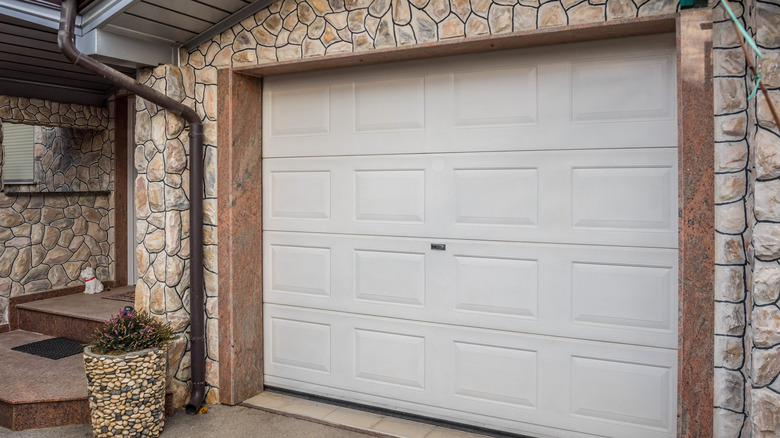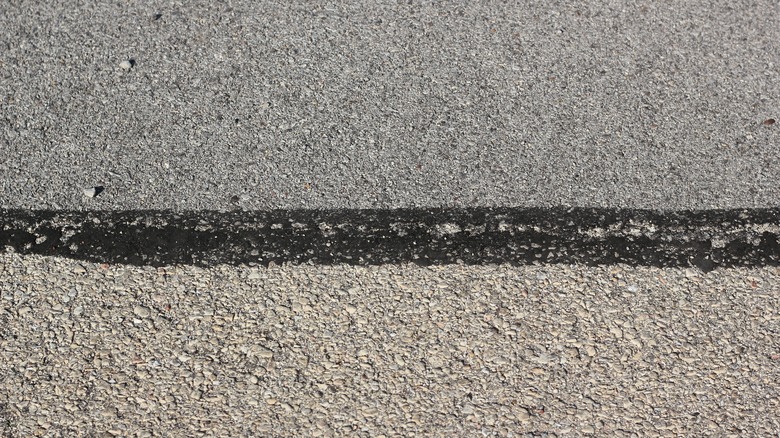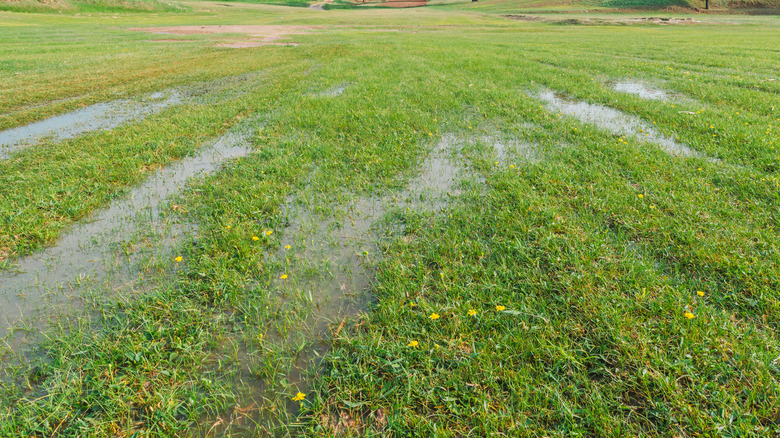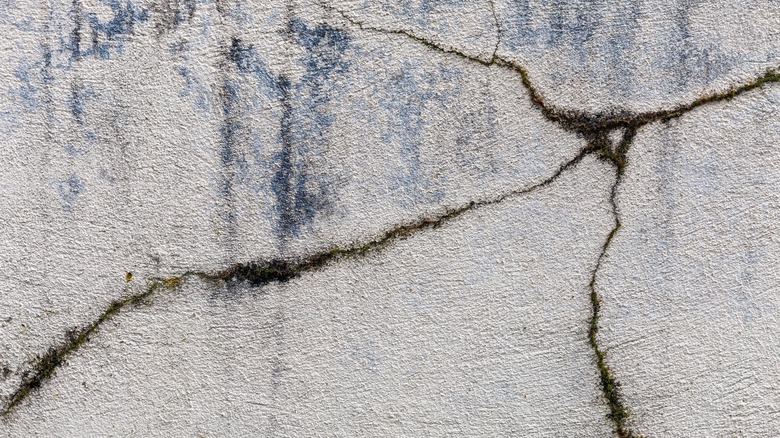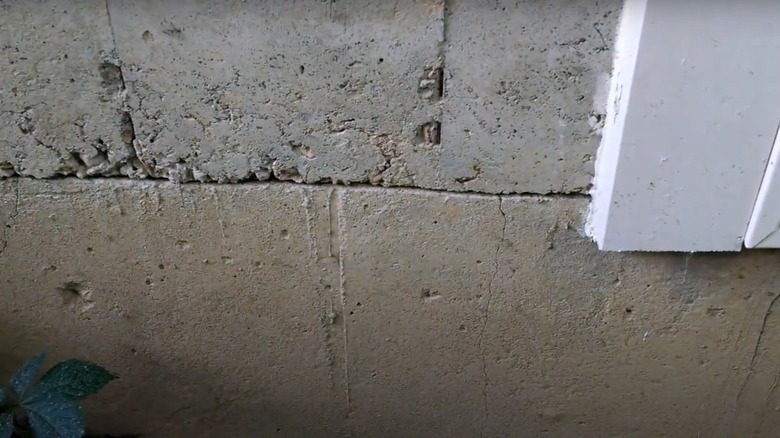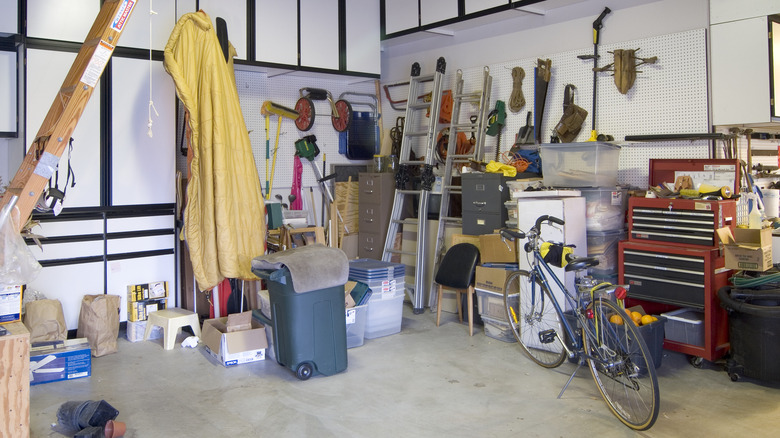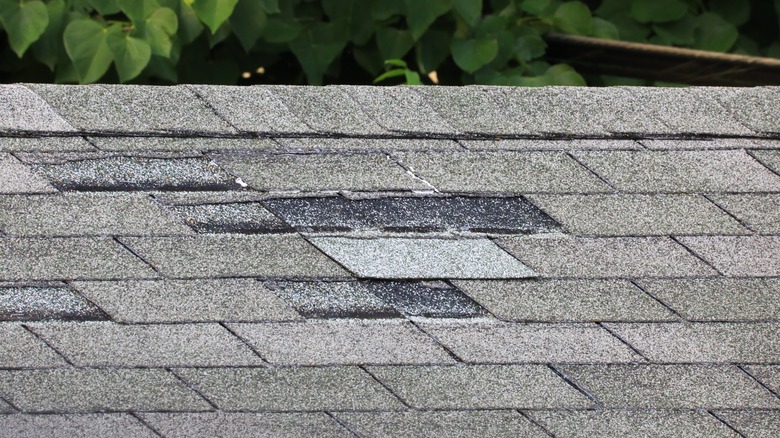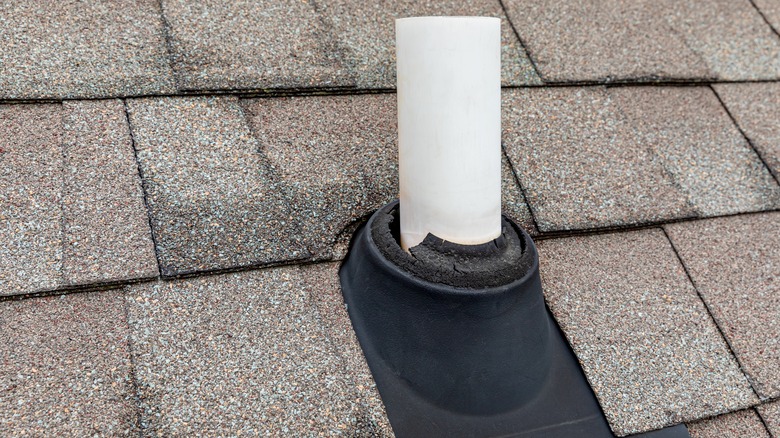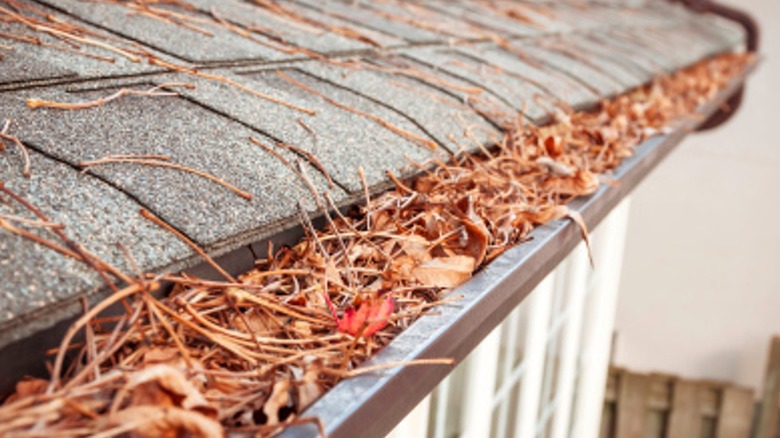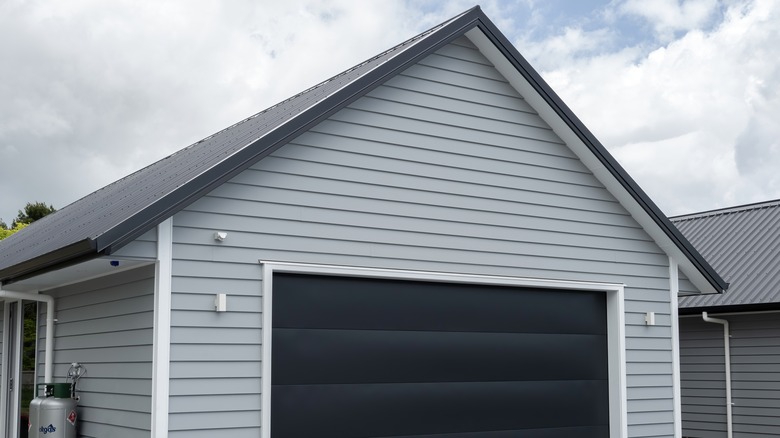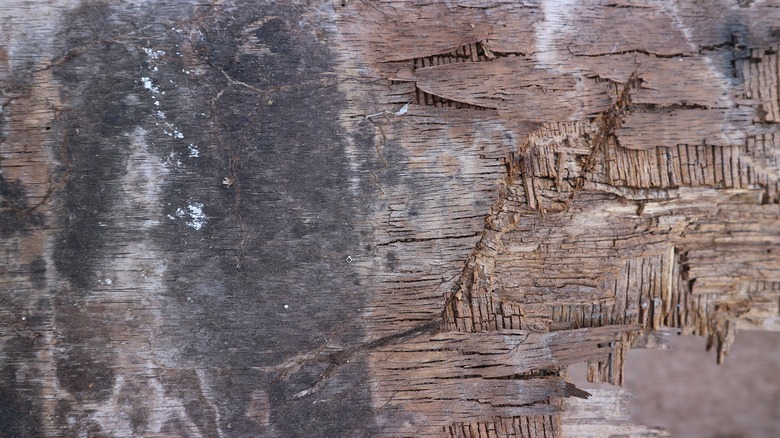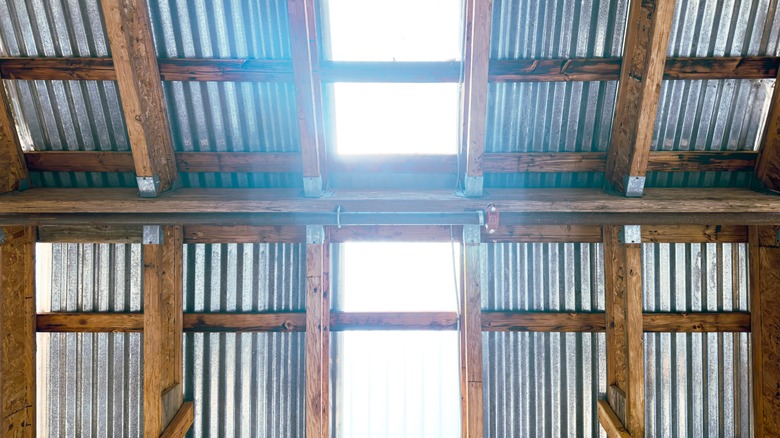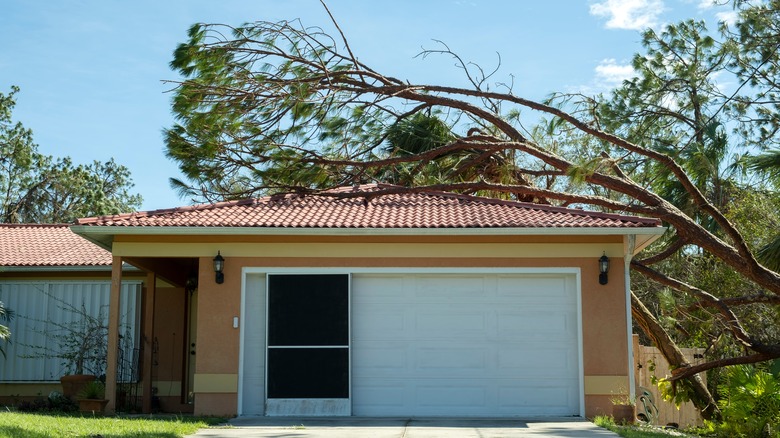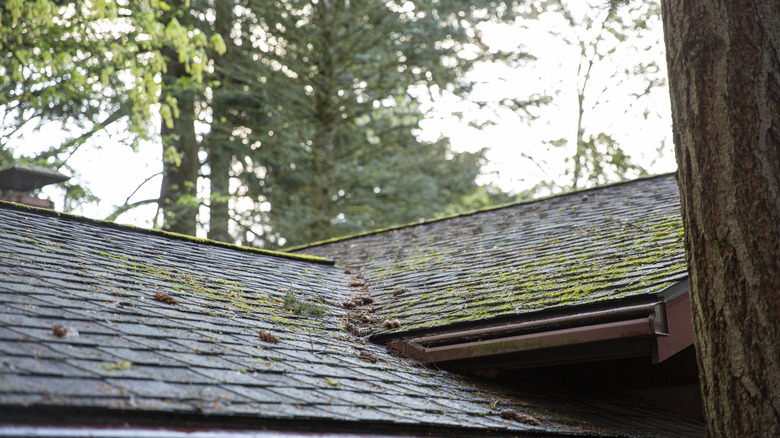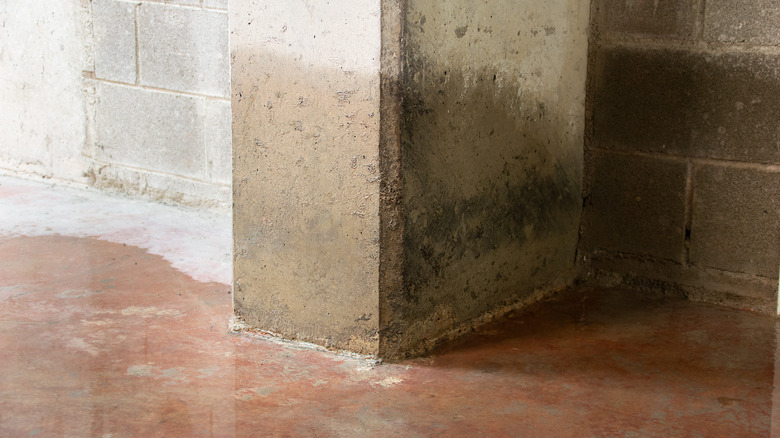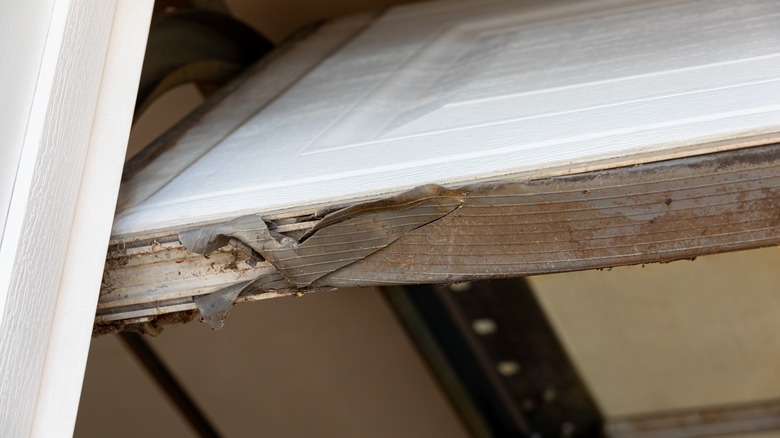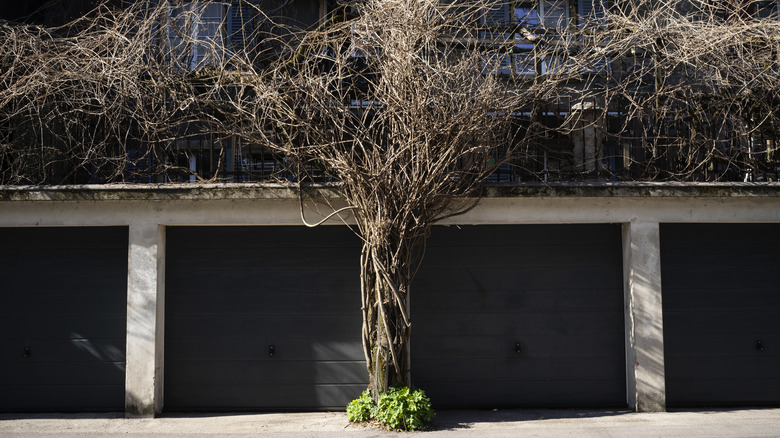Top Reasons Why Your Garage May Be Prone To Water Leaks (& What To Do About It)
We may receive a commission on purchases made from links.
If you're dealing with water leaks in your garage — particularly if it is a recurring issue — it can be beyond frustrating. Water can cause serious problems, including optimizing conditions for mold and mildew to grow, damaging the belongings you have stored in the space, and even threatening the structural integrity of the garage itself. While you certainly feel unlucky when you're faced with a water problem, there likely is an underlying problem that is letting water invade your space.
Without identifying the root cause of the water leaks, they're only going to keep occurring, leaving more damage and destruction in their wake. We reached out to roofing, plumbing, and lawn care experts to help us learn more about what might cause a garage to be prone to water leaks. Unfortunately, as you'll learn by reading their exclusive quotes, there are several possible explanations. Read on to learn more about what might be causing your water issues so that you can diagnose the problem and take the appropriate measures to remedy it.
Poorly sealed expansion joints can let water into a garage
When laying the concrete slabs in a garage, it is necessary to include expansion joints. These joints ensure that two slabs that are next to one another are able to move and shift on their own without bumping into a nearby slab as the temperature and humidity levels fluctuate. In an exclusive interview with House Digest, plumbing technician and owner of Plumbing Lab, Josh Mitchell, explained how a potential problem with expansion joints could allow water into the space. "If they aren't sealed well, water can seep through and lead to pooling or even structural damage over time."
Mitchell explains how this is a relatively simple problem to avoid — or remedy. He says, "Sealing expansion joints with a high-quality waterproof caulk or sealant can prevent water from seeping in. This is especially useful in areas that see heavy rain or snow melt." You should reapply the sealant every two years, and you can fill them yourself with either a silicone or polyurethane caulk. Use a silicone one if your joints are about an inch wide, and a polyurethane one if they're 1.5 inches wide. Silicone also tends to last longer than its counterpart, but it tends to cost more, so your pick depends on how often you want to repeat this project.
Improper grading around the garage can cause water to seep inside it
Grading is a term that refers to the slope of the terrain around your home. Ideally, you don't want the slope facing your home or garage, as that will send water towards the structure, instead of diverting it away from it. Ryan Farley, CEO of LawnStarter, told House Digest in an exclusive interview that poor yard grading is one of the top causes of water leaks in garages that he's seen with his customers. "The way water drains in your landscaping has more of an impact on your garage than you might think, especially since garage doors tend to not have the most secure or complete seals. So, if water drains off your yard toward your garage, then you might be seeing water leaking inside."
To remedy this situation, Mitchell explains the need to regrade around your garage. He says, "Regrading around your garage can involve adding soil to create a slope that leads water away from the foundation. Aim for a slope of 1 inch per foot for at least 5 feet away from the garage." You can learn how to properly grade your yard yourself, or you could hire a professional contractor to complete the task for you. Mitchell estimates that a professional will charge between $1,000 and $2,500, depending on the specific needs and scale of your project. If you don't want to undertake such a large project, then Farley suggests a simpler solution. "I'd recommend installing some extra drainage to help direct water away from your garage and driveway," he shares. While this can help, it's more of a band-aid since it won't completely fix the issue, and you might end up with seepage from time to time.
Cracks in the foundation may be to blame for water leaks in the garage
If there are any cracks in your garage's foundation, Mitchell warns that they could be to blame for the water issues you're dealing with. "Concrete naturally develops small cracks over time due to temperature changes and settling," he explains. Despite this being a natural process, the cracks may still be problematic, particularly if they are deeper or wider, as the risk of water entering increases, especially when it is raining heavily.
If there are cracks in your garage's foundation, you'll want to repair them. If they are relatively small, Mitchell explains that you can often seal them yourself. He recommends picking up an epoxy or polyurethane kit, like the Applied Technologies Fast Set Concrete Foundation Crack Repair Kit, to tackle this DIY project. However, he notes, "Hiring a professional might be necessary for larger cracks or structural issues, with repairs costing $500 to $2,500, depending on severity."
Cold joints may let water into a garage
The way the concrete for your garage floor was poured may lead to issues down the road, and might be the reason for your current water woes. Mitchell highlights the presence of cold joints as one such problem to be aware of. When a new pour of concrete is added to one that has already started to set, it is called a cold joint. Because the first layer of concrete was partially set when the new layer was added, the two do not bond properly. This can also happen between garage floors and walls. "Over time, these joints can sometimes develop small gaps, allowing water to seep through if drainage isn't sufficient," says Mitchell.
If cold joints are to blame for the water in your garage, Mitchell says, "Applying a flexible, waterproof sealant along the joint can help prevent leaks. These sealants are specifically designed for concrete joints and are relatively inexpensive, generally costing around $10–$20 per tube." If you're not sure whether a cold joint is to blame, consider hiring a professional to assess the situation for you.
Poor ventilation and condensation from humidity can cause water issues
If you've ever walked into your garage from your house, you're aware of the climate difference between the two structures. Most garages are not equipped with any heating, cooling, or ventilation system. Because of this lack of proper ventilation, Mitchell explains, "Humidity from the air condenses on cooler surfaces like the floor or walls, resembling a leak."
To remedy this problem, Mitchell says you should look for ways to increase the ventilation in the space. A few options include adding or opening windows or doors to the space to facilitate air circulation, or installing a fan. Another option is to consider fitting a breather vent or roof tile vent to prevent moisture from getting trapped in the space. "You can also add a dehumidifier if you live in a humid area. Installing a unit costs around $200–$300 for a mid-size garage, helping maintain a dry environment year-round," he says.
Damaged or worn shingles on the roof can let water in
Just as a damaged roof can provide an access point for water to get into your living space, it can also allow water to find its way into the garage. "Over time, garage shingles can become damaged due to constant exposure to harsh weather conditions like UV rays, rain, snow, and wind. This damage often appears as cracked, curled, or even missing shingles, especially in garages, which are often lower maintenance compared to the main house," Brendan Anderson of Brix Systems Roofing told House Digest in an exclusive interview.
If there's an issue with the shingles, you'll want to act quickly to determine whether roof repair or a full replacement is necessary. "If the shingles appear brittle and worn across the entire roof, a full roof replacement may be the best long-term solution to prevent leaks," he explains. However, if there are only a few damaged or missing shingles, a quick repair with some new ones may be sufficient.
Poor flashing installation or damage can also lead to leaks
Roof flashing may also be to blame for water getting into your garage. Anderson explains, "Flashing, the metal strip installed around roof areas like vents, chimneys, or where roof sections meet, is crucial for preventing leaks. When flashing is not installed properly or becomes damaged over time, it creates weak spots where water can easily seep in."
To avoid issues with damaged flashing, Anderson recommends inspecting it regularly. If you spot any damage, you can use a roofing sealant, like Liquid Nails Roof Repair, to reseal it and block water from penetrating into your garage. You might also want to consider upgrading your flashing entirely, especially if you know quality material wasn't used. "For garages that experience frequent flashing issues, consider upgrading to a more durable material, such as aluminum or steel, for added protection," he notes.
Clogged gutters — or ones that weren't installed correctly — can let water into the garage
Another potential cause of water entering your garage is the gutter system. If the gutters weren't installed correctly, that can be problematic. Anderson explains that gutters that are set at the wrong angle can allow water to overflow over the edges, making it more likely to penetrate through the walls or eaves of the roof. This highlights the importance of asking potential roofing contractors the right questions to ensure you're working with a reputable and responsible company. If you suspect your gutters are improperly installed, it's best to have a professional assess and make necessary adjustments.
Even if the gutters were installed correctly, they can still cause problems if they become clogged. Anderson recommends regularly cleaning the gutters to prevent debris buildup. He adds, "Installing gutter guards can help prevent clogs, while redirecting downspouts away from the garage helps avoid water pooling near the foundation or roof edges."
Improperly sealed roofing material may be to blame for leaks in the garage
According to Anderson, the materials used to make the roof for a garage are not always the same as those used over houses. This can lead to problems down the road. "Garages often have less commonly used roofing materials like metal or rubber, which may leak if not sealed properly. Water can penetrate these materials if they were not correctly installed or sealed, leading to potential leaks," he notes. "To address this, inspect the seals around seams and edges and use roofing sealant for minor gaps."
If improper seals are to blame, you'll need to evaluate the scope of the damage — or hire a professional roofing company to help you do so. While the roofing sealant can help with more minor issues, it won't always be sufficient. "If the sealing issue is widespread, consider professional resealing or even a full roof replacement for a more durable solution," he recommends.
Water can get in through cracks or gaps in roof sheathing or underlayment
The shingles on a roof are attached to the sheathing, or roof decking. This is a layer of plywood that is designed to provide support and improve the overall strength and integrity of the roof. Anderson explains that improper installation or moisture damage can cause the decking to crack, creating problems. "These cracks can allow water to seep through and damage the interior of the garage," he says.
If you suspect the sheathing is contributing to your water issues, you'll want to take steps to remedy the problem. Anderson recommends using roofing cement, such as the Henry Wet Patch Roof Leak Repair, to fix small cracks. However, he notes, "If damage is extensive, replacing the sheathing might be necessary."
Leaks from skylights, vents, or rooftop equipment can also allow water to make an entrance
Any time you add anything to your roof, it opens up the potential for failure that will allow water to enter the space. "Many garages have ventilation openings, skylights, or small exhaust fans, all of which can let water in if not sealed correctly. These features can wear down over time, allowing leaks to occur," Anderson explains. He recommends frequently inspecting the seals around these features and applying a roof sealant or caulk to stop water from passing through.
Joshua Riutta, the owner of Mikku and Sons Roofing, highlights any equipment that is installed on the rooftop as another potential culprit for a leak. In an exclusive interview with House Digest, Riutta says, "Leaks can also develop around rooftop equipment such as HVAC systems or plumbing vent pipes. These leaks occur at the penetrations where these fixtures meet the roof." He also recommends checking the seals around these fixtures and replacing any that look worn. Additionally, he notes that new flashing may be needed in some cases.
Damage from the elements might also allow water into the space
If you live in an area prone to natural disasters or severe storms — or even just end up with a heavy thunderstorm — it may cause damage to the garage that will open up an entry point for water to intrude. While damage can happen to any part of your room, Anderson notes, "Garages, often being lower than the main house, are more susceptible to impact from falling branches, hail, and high winds, which can damage shingles or even puncture the roof itself."
While you won't be able to stop a storm from impacting your garage, you can take measures to minimize the water, and the damage that comes with it, that is allowed to enter your space. Anderson recommends taking some time to inspect the garage and its roof after a major weather event. He says to look for broken or completely missing shingles and any other signs of damage, and then to act quickly to get them repaired. To minimize the risk of damage from future storms, he suggests trimming back any branches that are hanging over the garage. He adds, "In areas prone to severe weather, upgrading to a more durable roofing material may help minimize future repairs."
Age and regular wear and tear may be sufficient to let water get into the garage
Sometimes, the cause for the water may simply boil down to the age of your roof. "Over the years, roofing materials naturally wear down, reducing their ability to keep water out. Even with no specific damage, exposure to the elements eventually takes a toll," explains Anderson.
He recommends having a roofing professional perform regular inspections to identify minor problems before they turn into something major. In some cases, a simple repair could remedy this problem, but putting band-aids on more serious issues can't be a lasting solution. "If your garage roof is nearing 20 years old, it might be time for a replacement," he explains.
Inadequate insulation can lead to accumulating moisture and water damage
Unfortunately, because they are not part of the main living space in a home, many builders do not add much — if any — insulation to a garage. Riutta cites this as another potential cause of water damage in a garage. He warns, "Inadequate insulation in your garage can lead to temperature fluctuations that cause condensation to form. This moisture can accumulate on various surfaces, including walls, ceilings, and floors, giving the impression of leaks."
If you believe that insufficient — or missing — insulation is to blame for the water issues in your garage, Riutta explains, "Upgrading to higher-quality insulation or adding more insulation can help regulate temperatures and minimize condensation." If opening the walls to add insulation, he notes that adding a vapor barrier can also help with moisture problems by keeping the water out. Add it between the studs and drywall, facing the interior of the garage, as this will keep warm, moist air from moving into the cooler exterior walls.
Poorly installed or damaged garage door seals can let rainwater into the space
Your garage door, or more specifically, the seal at the base of it, could also be to blame for the water problems you're dealing with. Riutta says, "If the seals at the bottom or sides of the door are worn or improperly installed, rainwater can easily seep in." The purpose of the seal at the bottom of the door is to create a barrier that moisture is unable to penetrate; a damaged seal won't be able to form a strong enough barrier to accomplish this goal.
"To combat this issue, check the rubber seals for signs of damage," he recommends. If you notice any damage, replace the bottom seal of the garage door yourself, or hire a professional garage repair company to complete the job for you. After replacing the seal, test the door and examine how well it closes. "Ensuring that your garage door closes tightly will also minimize the risk of leaks," Riutta shares.
Roots from trees or plants may lead to water issues
Look around your garage. Are there any trees or nearby plants that are close enough that their roots can intrude on the space? Keep in mind that the roots of large trees can spread well beyond the end of their crown. According to Riutta, if these roots penetrate beneath the foundation, they can cause cracks or other access points where water can get in.
"If you suspect that root intrusion is a problem, consider consulting with a landscaping or foundation professional to assess the situation. In some cases, removing or trimming back nearby trees and plants may be necessary to prevent further damage and water leaks," he notes. Making the decision to remove a tree is never an easy — or a cheap — one, but it may be the only option if the roots are causing that much of an issue.
